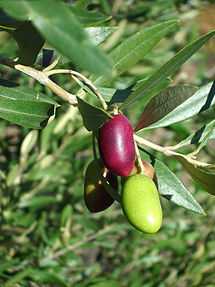Lucques
| Lucques | |
|---|---|
|
Lucques olives ripening on the tree | |
| Olive (Olea europaea) | |
| Color of the ripe fruit | Green |
| Also called | Lucquoise, Olivier Odorant, Oliverolle |
| Origin | France |
| Notable regions | Languedoc |
| Hazards | Olive fruit fly, sooty mold, Verticillium dahliae etc. |
| Use | Oil and table |
| Oil content | Medium |
| Fertility | Self sterile |
| Growth form | Spreading |
| Leaf | Elliptic-lanceolate |
| Weight | Medium |
| Shape | Elongated |
| Symmetry | Asymmetrical |
The Lucques is a cultivar of olives grown primarily in Languedoc in France. It is primarily used as a green table olive.[1][2] It can also produce high quality oil, but this is hard to extract. Though vulnerable to certain pests, it is relatively resistant to cold and drought.
Extent
The Lucques owes its French name to the tradition that it originated in the Italian province of Lucca (Lucques in French); today it is primarily associated with southern France, particularly in Languedoc's,[3] Roussillon and Hérault regions.[1] It can also be found in Northern Africa, Turkey, the United States and Australia.[4]
Synonyms
Locally, this cultivar is known under a number of different names, including Lucquoise or Luquoise, Oliva Lucchese, Oliverolle, Olivier de Lucques, Olivier Odorant and Plant du Languedoc.[4]
Characteristics
It is a cultivar of good strength, with a spreading growth form in a shape described as "a vase or a parasol".[1] The leaves are elliptic-lanceolate, with a medium length and width.[5] The olives are of medium to high weight, with an average commercial caliber of 20 to 24 fruits/hecto.[1] They have an elongated, asymmetrical shape, with a pointed apex and a truncated base.[6] The stone is pointed at both ends, with few groves and no mucro.[7]
Though the fruit comes into bearing early, its ripening is late.[5] Picking is at the end of October or beginning of November, while the skin is a light green. It matures in December, and when fully mature the colour of the fruit is green.[1]
Processing
The Lucques is primarily used as a green table olive, and the fruit tastes meaty and sweet.[2] Some compare it to fresh almonds and avocados.[1] It is a highly valued olive among gourmets.[1] It can also be used for oil, and the oil it produces is of excellent quality, but it is difficult to extract.[5] It gives a medium oil yield, of about 17%.[1] The smell of the oil has alternately been described as "almond", "green apple", and "tomato".[8] The taste is sweet; to some excessively so.[3]
Agronomy
It is considered a productive cultivar, but depends on good quality soil and regular irrigation to give a high yield.[1][5] The cultivar is self-sterile, so it depends on other pollinators.[8] It is vulnerable to certain pests, including the olive fruit fly, sooty mold and Verticillium dahliae.[9] On the other hand, it has a moderately good tolerance to cold and drought.[5]
See also
- Picholine (Fausse Lucques)
References
- ↑ 1.0 1.1 1.2 1.3 1.4 1.5 1.6 1.7 1.8 "More about Lucques olives". Lacassagne estate. Retrieved 2009-01-17.
- ↑ 2.0 2.1 Lebowitz, David (2006-04-28). "Lucques Olives". David Lebowitz. Retrieved 2009-01-17.
- ↑ 3.0 3.1 Courboulex, Michel (2002). Les oliviers (in French). Paris: Éditions Rustica. p. 43. ISBN 2-84038-635-6.
- ↑ 4.0 4.1 "Cultivar name: Lucques". OLEA Databases. Retrieved 2009-01-17.
- ↑ 5.0 5.1 5.2 5.3 5.4 "Luques". Santa Cruz Olive Tree Nursery. Retrieved 2009-01-17.
- ↑ "Lucques". International Olive Council. Retrieved 2009-01-17.
- ↑ "Morphological characters for cultivar Lucques". OLEA Databases. Retrieved 2009-01-17.
- ↑ 8.0 8.1 "Agronomical characters for cultivar Lucques". OLEA Databases. Retrieved 2009-01-17.
- ↑ "Susceptibility to biotic stress for cultivar Lucques". OLEA Databases. Retrieved 2009-01-17.
| ||||||||||||
